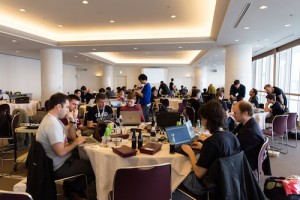Between the 3rd and the 8th of April 2016, the Internet Engineering Task Force (IETF) group met in Buenos Aires, Argentina. Bill Jensen and James Dishongh are two of the network engineers involved in the design and deployment of the network infrastructure that provided wired and wireless connectivity to the convention’s attendees.

Since Bill and James are two network veterans with many years of experience in designing and deploying networks for conventions, when they asked us if they could use NetBeez to monitor the IETF 95 network, we were very happy to provide some Beez in support.
In this post, James and Bill tell us a little more about what IETF is about, how the convention’s network was built and deployed, and how they used NetBeez in support of their users.
What is IETF 95?
The IETF is a group of people who work together to “make the Internet work better by producing high quality, relevant technical documents that influence the way people design, use, and manage the Internet.” They’re programmers, network gurus, hackers, and researchers who have built many of the protocols and standards we use today. We usually have anywhere from 900 to 1300 attendees depending on the venue location. In Argentina we had 932 attendees and set a new record of 555 remote participants.
What services did you offer to your users?
The IETF NOC Team builds a complete publicly routed IPv4 and IPv6 network for their attendees. We provide secure and legacy wifi in the meeting space and common areas such as the main hotel lobby. We also used a dry VLAN to get our bandwidth into the venue hotel’s sleeping rooms. We also provide work spaces and printers for attendee use as well as VoIP conference phones.
What was the network design like?
Our networks are usually fairly simple router-on-a-stick designs. We typically bring in two circuits from two providers terminated on separate routers, which are connected to a core switch. For IETF 95 we brought in three circuits. Behind the core switch sits our LAN infrastructure: switches, servers, and access points. We have a handful of host machines running DNS and DHCP as well as several VMs providing configuration management, monitoring, ticketing, wikis, and storage among various other things. While the network design isn’t complex per se, the circuit turn up is challenging because we’re remotely planning with foreign companies with whom we have little or no direct working experience. You just don’t call up the local providers and say “Hey, we need bits.” There’s quite a few more caveats. Luckily we have contacts all over the world who make this a bit easier, and our host in Argentina was superb. And don’t even get us started on the internal design. We’ve been in so many venues with several data closets, all with different fiber and connector types between them. Luckily, our venue in Argentina only had four data closets, to all of which we had unfettered 24-hour access. That’s not always the case.
What challenges did you face during the event?
Perhaps one of the biggest challenges we always face is communicating to the hotel, our hosts, and our circuit providers what it is that we’re trying to do. While we know what we’re doing, our local resources just aren’t used to a group coming in and doing everything for themselves. We plan it, design it, ship it, and build it all ourselves. They’re just not used to that. While we had a couple typical issues — routing and a hardware crash– our biggest challenge at this event was self-imposed; We’re changing many of our internal processes from deployment preparation to documentation.
Why did you decide to install and run NetBeez at IETF 95?
We wanted a way to know our attendees’ user experience. The NOC team is often on our management network, so we’re isolated from the hiccups our attendees might experience and the NetBeez give us a great way to see what our attendees see.
What was your NetBeez setup like (number/type of agents, targets/tests configured)?
We deployed 16 agents (We like that word, “agents” — it sounds so cool and makes us feel like we’re running a spy operation!). Seven of our agents were NetBeez (Thank you!) and were deployed in various locations throughout the venue, including four in our main ballroom. We left two agents in the US, so they were probing targets inside our network. The remaining agents were with us in Argentina, targeting each other, key internal servers, external websites, and doing traceroutes to external servers. We had well over 100 total targets. Keep in mind we run several SSIDs, so we used the agents to probe targets from each SSID. We do this so we can isolate issues; e.g. ‘Is the problem isolated to the IETF SSID or are we seeing it across the board?’ Maybe it’s an authentication issue or a DHCP scope issue, or an infrastructure issue affecting users in just one part of the venue. Having the NetBeez [agents] spread across the hotel was great. They gave us instant feedback on several parameters.
Did you discover anything interesting with NetBeez during the event?
We’re really just getting into the groove of using the NetBeez [agents] and discovering their utility, but we’re convinced that they’re great for troubleshooting issues like we described above. It took us a few days just to discover all the features on the interface and to find out how we could use those tools for our needs. We treated the [agents] like a user who stayed in the same place, gathering data 24 hours a day, offering feedback on connectivity, response times, and availability.
What features would you like to see implemented in NetBeez?
Well… IPv6 support would be nice. 🙂 We’d also like to see a fifth tool, a ‘DIY’ command interpreter so to speak. We’d like to be able to pass our own commands thru the Agent Console and see the results.
Would you like to add anything else?
We really appreciate the donation, and more importantly we really appreciate access to the web interface. We can tell you’ve spent a lot of time building a clean and well organized interface. The targeting tools and graphs are lean yet beneficial. We like what you’ve built so far and can see that it will be really useful as we continue to learn more about the interface and how we can use it. Now that we’ve gotten our feet wet at one event, we’re starting to understand how we can use the data we gather, and more importantly, we’ll begin integrating the NetBeez into our troubleshooting processes. We’re looking forward to the changes we’ll see between now and our next event. Happy Bee-keeping!





